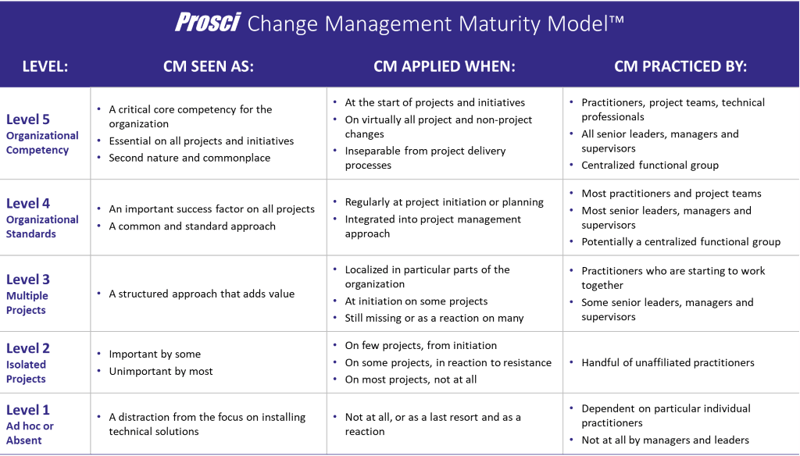How to Use the Prosci Maturity Model

5 Mins
Updated: December 23, 2023
Published: August 23, 2018

With the velocity of change and the demand to deliver expected outcomes and results increasing, leaders are recognizing that organizational change maturity is no longer a luxury but is in fact a necessity.
Prosci began its research and development on embedding organizational change capability back in 2004 with the development and release of the Prosci Change Management Maturity Model™. The Prosci Maturity Model has enabled countless organizations to document their current level of maturity and develop actionable plans to increase their maturity.
This article provides an overview of the Prosci Maturity Model and the associated Prosci Maturity Model Audit, which provides a quantitative diagnostic of maturity. It concludes with four primary use cases for applying the Prosci Maturity Model, identified by advanced practitioners at a recent industry event:
- Measuring maturity
- Aligning stakeholders
- Guiding actions
- Clarifying approach
Prosci Advisory Services
Get Guidance and hands-on support with your projects and initiatives when you partner with Prosci.
Learn More
Prosci Change Management Maturity Model Framework
The Prosci Change Management Maturity Model presents five levels of organizational maturity in change management:
- Level 5: Organizational Competency
- Level 4: Organizational Standards
- Level 3: Multiple Projects
- Level 2: Isolated Projects
- Level 1: Absent or Ad hoc
As an organization moves up the levels in the Prosci Maturity Model, change management occurs on more projects and initiatives and in more parts of the organization. Employees participate in change management more broadly throughout the organization, and employees begin to internalize their role in making change successful based on their relationship to change. The organization takes steps to embed and integrate change management into more functions in the organization. Ultimately, projects and initiatives are more successful, evidenced in improved realization of benefits and achievement of desired outcomes.
The table below provides descriptions of how change management is perceived, when change management is applied, and who is practicing change management for each of the five levels.

Observable Capability Areas for Change Management Maturity
As part of the buildout of the Prosci Maturity Model in 2012, Prosci reviewed the research and extensive client experiences to identify observable dimensions of maturity. The result of the analysis was five observable observable capability areas: Leadership, Application, Competencies, Standardization and Socialization.
Capability Area 1: Leadership
The Leadership capability area focuses on specific leadership activities that center around building organizational change management competencies. How committed is leadership to organizational change management? Which activities or messages is the leadership undertaking to communicate the value of change management and the effort to build an internal competency? Who is sponsoring change management deployment? If your organization scores low in the Leadership capability area, then this is the first area you should focus on when building an organizational competency.
Capability Area 2: Application
In the Application capability area, you look at the use of change management processes and tools on projects and initiatives within your organization. What percentage of projects are applying change management? Are there people and funding available for applying change management on projects and initiatives across the organization?
Capability Area 3: Competencies
Change management is ultimately applied by employees, supervisors, managers, leaders, project teams and practitioners throughout the organization. The third capability area, Competencies, looks at the training and development of key groups that must apply change management tools and principles. Ask these questions: Whom have you trained? Have they demonstrated change management competencies?
Capability Area 4: Standardization
The Standardization capability area looks at the mechanisms and systems used to institutionalize change management. Is every part of your organization using the same change management approach? Have you integrated change management with project management? Have you included change management in other improvement approaches? Standardization is the capability area that enables effective change management to become a fixed component of how the organization introduces change.
Capability Area 5: Socialization
The fifth and final capability area, Socialization, focuses on building commitment and buy-in for change management. Effectively building capabilities and competencies requires buy-in and commitment from every level of an organization. Does the organization view change management as a competitive differentiator and core competency? Is there reinforcement in place to sustain change management application at every level of the organization?
Prosci Maturity Model Audit Evaluation
The Prosci Maturity Model Audit involves evaluating 50 specific, observable traits across the five capability areas using a rubric scoring system. Organizations work with Prosci Change Management Advisors to conduct a full Maturity Model Audit at the start of engagements.
.png?width=800&name=download%20(1).png)
For each of the 50 factors, deployment leaders are presented with descriptions of a Level 1, Level 2, Level 3, Level 4 and Level 5 organization. By selecting the description that best matches the organization, users build out a more sophisticated and complete view of organizational change management maturity. Below are two examples of the rubric scoring used for the 50 factors that make up the Prosci Maturity Model Audit:
.png?width=800&name=download%20(2).png)
The results of the Prosci Maturity Model Audit include an overall score (out of 5), scores for each of the five capability areas, and a question-by-question report.
Using the Prosci Maturity Model
The Prosci Maturity Model is an invaluable addition to the toolbox for change leaders looking to add flexibility and durability as a core competency of their organization.
The audit and the results are valuable in several capacities in the effort to deploy change management more broadly throughout an organization. At a recent gathering of change deployment leaders, we collaborated to create a list of uses of the Prosci Maturity Model Audit. Analysis of the raw input yielded four main uses:
- Measuring maturity
- Aligning stakeholders
- Guiding actions
- Clarifying approach
Measuring Maturity
The Prosci Maturity Model Audit enables a strong evaluation and quantification of overall change maturity using comprehensive factors and rubric scoring. As an audit, organizations can use these scores in several ways, including:
- Baselining current maturity level
- Setting goals and targets for future maturity level
- Tracking progress on the enterprise change management (ECM) journey
Aligning Stakeholders
Stakeholders are often familiar with maturity models, even if they are less familiar with change management. The construct of the Prosci Maturity Model, along with the descriptions and capabilities areas, enable the creation of a shared sense of perspective and purpose. Specific examples of this use case include:
- Aligning partners for the ECM journey
- Creating a shared view of maturity across a steering committee or team
- Encouraging senior leadership to commit to action
- Engaging key stakeholders and decision makers
- Gaining commitment from senior leaders for the ECM journey
- Justifying the case for an investment in ECM
- Managing expectation of what growing change maturity requires
- Standardizing on a single view of maturity and current level
Guiding Actions
Once we know where we are and where we want to be, we can figure out how to get there. The natural extension of using the Prosci Maturity Model to establish a baseline and target is to use it to formulate action steps to close the gap. Example tactics for guiding action include:
- Building a roadmap to maturity that people can get behind
- Complementing formal ECM strategies and tactics (like the Prosci ECM Strategy Map)
- Creating tasks and roles for increasing maturity
- Driving decisions on focus, investment and tradeoffs
- Ensuring we don't forget anything on the ECM journey
- Focusing on practical next steps in most important areas
- Identifying gaps that need to be addressed
- Prioritizing and sequencing action steps
Clarifying Approach
While leaders may agree that they need change maturity, this is still often a nebulous concept for many outside and even inside the community. Prosci’s research foundation provides a structured and accessible approach to demystifying change management, including:
- Adding clarity to the definition of "maturity"
- Briefing stakeholders on progress toward maturity
- Demystifying the approach and process to building maturity
- Educating others on change management and maturity
- Making change maturity tangible
- Sharing the roadmap with others
What's Next
To keep pace with the accelerated velocity of change and see greater ROI on projects, organizations have to change the way they operate—and especially how they manage change. The Prosci Change Management Maturity Model and Prosci Maturity Model Audit give you the insights you need to assess your organization’s change maturity level and map out a strategy for growing your change competency. By advancing your maturity level, you’re focusing more and more on the people side of change, leading to greater success on your projects and initiatives. Contact us to learn more.



